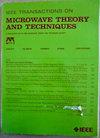Fully Integrated Multimode Orbital Angular Momentum Wave Generation at 360 GHz Using SiGe BiCMOS
IF 4.1
1区 工程技术
Q2 ENGINEERING, ELECTRICAL & ELECTRONIC
IEEE Transactions on Microwave Theory and Techniques
Pub Date : 2025-01-06
DOI:10.1109/TMTT.2024.3522803
引用次数: 0
Abstract
This article presents a fully integrated multimode orbital angular momentum (OAM) transmitter using a circular slot cavity antenna, capable of concurrently operating three orthogonal OAM modes (利用SiGe BiCMOS产生360 GHz全集成多模轨道角动量波
本文介绍了一种完全集成的多模轨道角动量(OAM)发射机,采用圆形槽腔天线,能够同时工作三个正交的OAM模式($|l_{\text {OAM}}| =0$, 1和2),同时保持一个共同的相位中心。这允许使用无源增益元件,如透镜或反射器来增强指向性。此外,发射机利用高阶腔模式消除了复杂的多相馈电网络。本文对辐射电磁波的角动量(AM)以及天线模式与OAM/SAM模式的关系进行了详细的研究。单元件发射机由一个120 ghz振荡器和一个带谐波滤波网络的p-i-n二极管三频器组成。该发射机可产生360 ghz信号的OAM波,峰值辐射功率为- 8.1 dBm, dc-to-THz效率为0.1%。它还具有14.2%的宽频率调谐范围。该芯片采用GlobalFoundries的90纳米BiCMOS工艺制造。除了发射机设计之外,本工作还介绍了一种测量OAM振幅和相位分布的方法,该方法不需要Tx/Rx频率和相位相干性,从而简化了测量过程并确保了OAM模式的准确表征。它能够同时在多个OAM模式下工作,结合其紧凑高效的设计,突出了其未来安全高容量通信应用的潜力。
本文章由计算机程序翻译,如有差异,请以英文原文为准。
求助全文
约1分钟内获得全文
求助全文
来源期刊

IEEE Transactions on Microwave Theory and Techniques
工程技术-工程:电子与电气
CiteScore
8.60
自引率
18.60%
发文量
486
审稿时长
6 months
期刊介绍:
The IEEE Transactions on Microwave Theory and Techniques focuses on that part of engineering and theory associated with microwave/millimeter-wave components, devices, circuits, and systems involving the generation, modulation, demodulation, control, transmission, and detection of microwave signals. This includes scientific, technical, and industrial, activities. Microwave theory and techniques relates to electromagnetic waves usually in the frequency region between a few MHz and a THz; other spectral regions and wave types are included within the scope of the Society whenever basic microwave theory and techniques can yield useful results. Generally, this occurs in the theory of wave propagation in structures with dimensions comparable to a wavelength, and in the related techniques for analysis and design.
 求助内容:
求助内容: 应助结果提醒方式:
应助结果提醒方式:


